Japanese Keio University
Keio University is a Japanese university located in Minato, Tokyo. It is known as the oldest institute of higher education in Japan. Founder Fukuzawa Yukichi originally established it as a school for Western studies in 1858 in Edo (now Tokyo). It has eleven campuses in Tokyo and Kanagawa. It has nine faculties, with Letters, Economics, Laws, Business and Commerce, Medicine, Science and Technology, Policy Management, Environment and Information Studies, Nursing and Medical Care, and Pharmacy.
The alumni include three Japanese prime ministers and prominent corporate leaders. Currently twelve Keio graduates engage as the Fortune Global 500's CEOs.
Keio University as seen from Tokyo Tower
Overview

The founder of Keio Fukuzawa Yukichi's statue on Hiyoshi campus.

East Research Building in Mita

Kyoseikan in Hiyoshi
Keio traces its history to 1858 when Fukuzawa Yukichi, who had studied the Western educational system at Brown University in the United States, started to teach Dutch while he was a guest of Okudaira family. In 1868 he changed the name of the school to Keio Gijuku and devoted all his time to education. While Keiō's initial identity was that of a private school of Western studies, it expanded and established its first university faculty in 1890, and became known as a leading institute in Japanese higher education. It was the first Japanese university to reach its 150th anniversary, celebrating this anniversary in 2008.
In 2009, Keio University was selected as one of "Global 30" universities, a government program "which is aimed at elevating... international competitiveness among the world's top universities and at creating an attractive environment for overseas students, while fostering students and researchers capable of playing active international roles."
Keio has leading research centers. It has approximately 30 Research Centers located on its five main campuses and at other facilities for advanced research in Japan Keio's School of Medicine has long-standing research links with the Harvard Medical School. Keio University has joined the MIT and the French INRIA in hosting the international World W3C.
Mission
Fukuzawa stated the mission of Keio shown below, which is based on his speech for the alumni's party on November 1 in 1896.
Keio Gijuku shouldn't be satisfied with being just one educational institution.
Its mission is expected to be a model of the nobility of intelligence and virtue,
to make clear how it can be applied to its family, society, and nation,
and to take an actual action of this statement.
It expects all students being leaders in society by the practice of this mission.
Its mission is expected to be a model of the nobility of intelligence and virtue,
to make clear how it can be applied to its family, society, and nation,
and to take an actual action of this statement.
It expects all students being leaders in society by the practice of this mission.
Those sentences were given to students as his will, and considered as the simple expression of Keio's actual mission.
Academic culture
Contributor to Japanese modern education systems
Keio is known that it has primarily introduced many modern education systems in Japan. The followings are the examples.
- Keio is the earliest Japanese school that introduced the annual fixed course fee, designed by Fukuzawa.
- It initially introduced the culture of speech to Japan, which Japan had never had before. It built Japan's earliest speech house Mita Speech House in 1875 as well.
- It is regarded as Japan's first university which accept the international students. Keio accepted 2 Korean students in 1881 as its (and also Japan's) first international students. 60 Korean students entered in 1883 and 130 Korean students in 1895.
Dokuritsu Jison
Keio put "Independence and self-respect as a fundation of its education. This is meant to be physically and mentally independent, and respect yourself for keeping your virtue. Independence and self-respect are also regarded as Fukuzawa's nature and essence of his education.
Hangaku Hankyo
Learning half and teaching half is the other unique culture in Keio. During the late Edo period and the early Meiji period, several private prep schools often used students as assistant teachers and it was called "Learning half and teaching half". Keio also had initially used this system. In the early period of such schools of Western studies, there had been many things to learn not only for students but also professors themselves. Hence there had been sometimes the occasions that students who had learned in advance had taught other students and even professors. After the proper legal systems for education had been set up, those situations have been disappeared. However, Fukuzawa thought the essence of academia is a continuous learning, and knowing more things provides more learning opportunities. Keio respects his thought and put the rule in "Rules in Keio Gijuku that there shouldn't be any hierarchy between teachers and learners, and all of the people in Keio Gijuku are just in a same company. For this reason, there is still a culture in this university that All professors and lecturers are officially called with the honorific of "Kun" but never "Teacher" or "Professor".
Shachu no Kyoryoku
Collaboration in a company is also a uniqueness of Keio. Fukuzawa stated in 1879 that the Keio's success today is because of the collaboration in its company, and "Collaboration in a company" originally came from this article. People in Keio often think that all of the people related to Keio (e.g. professors, students, alumni and their family members) are the part of their company, thus they should try to help each other like brothers and sisters. This culture has been often seen especially in the alumni organization called Mita-Kai.
History

Keio Gijuku in Tsukiji in 1862

The lecture of Economics by Fukuzawa during the Battle of Ueno on May 15, 1868

Keio University in May 1912
Keio University was established in 1858 as a School of Western studies localted in one of the mansion houses in Tsukiji by the founder Fukuzawa Yukichi. Its root is considered as the Han school for Kokugaku studies named Shinshu Kan established in 1796. Keio changed its name as "Keio Gijuku" in 1868, which came from the era name "Keio" and "Gijuku" as the translation of Public school. It movied to the current location in 1871, established the Medical school in 1873, and the official university department with Economics, Law and Literacy study in 1890.
Keio has been forming its structure in the following chronological order.
| Year | University development |
|---|---|
| 1858 | Keio Gijuku was established |
| 1879 | It rejected an offer to become a national university. Instead of that, it became a vocational school funded by Daimyos including Shimazu clan. |
| 1890 | University department with Faculty of Economics, Faculty of Law, and Faculty of Letters was set up |
| 1906 | Graduate school was set up |
| 1917 | School of Medicine was set up |
| 1920 | It was authorized as a university in the prewar system |
| 1944 | Faculty of Technology was set up |
| 1949 | It was authorized as a university in the post-war system |
| 1957 | Faculty of Business and Commerce was set up |
| 1962 | Graduate School of Business Administration was set up |
| 1981 | Faculty of Science and Technology (reformed from Faculty of Technology) was set up |
| 1990 | Faculty of Environment and Information Studies and Faculty of Policy Management were set up |
| 1994 | Graduate School of Media Design was set up |
| 2001 | Faculty of Nursing and Medical Care was set up |
| 2004 | Law School was set up |
| 2008 | Faculty of Pharmacy was set up |
There have been several notable things in Keio's over 150 year history as shown below.
- Keio launched Hiromoto Watanabe as a first chancellor of the Imperial University (University of Tokyo) in 1886. He is the first chancellor of the officially authorized university in Japan.
- Keio sent 6 students to abroad in 1899. In the same year, it accepted three international students from India, Qing Dynasty China, and Thailand. Eight international students entered from Taiwan (which had technically been a territory of the Japanese Empire since 1895) in the next year.
- Keio was visited by Bengali poet Rabindranath Tagore where he made a speech in 1916.
- Keio was visited by Albert Einstein where he presented a lecture on the special theory of relativity in 1922.
- It started to accept female students in 1946.
- A paper written by Keio undergraduate student as the first author was placed in the research journal Science in 2006, which had rarely happened to any undergraduate students.
- Keio was visited by Prince Charles in 2008.
Presidents
Since the president system was established in 1881, there have been 18 presidents in Keio's history.
| President | Tenure | President | Tenure | President | Tenure | President | Tenure | ||||
|---|---|---|---|---|---|---|---|---|---|---|---|
| 1. | Sadashiro Hamano | 1881–1887 | 7. | Shinzo Koizumi | 1933–1947 | 13. | Saku Sato | 1969–1973 | 19. | ||
| 2. | Nobukichi Koizumi | 1887–1890 | 8. | Seiichiro Takahashi | 1946–1947 | 14. | Hiroshi Kuno | 1973–1977 | 20. | ||
| 3. | Tokujiro Obata | 1890–1897 | 9. | Kouji Ushioda | 1947–1956 | 15. | Tadao Ishikawa | 1977–1993 | 21. | ||
| 4. | Eikichi Kamata | 1898–1922 | 10. | Fukutaro Okui | 1956–1960 | 16. | Yasuhiko Torii | 1993–2001 | 22. | ||
| 5. | Ichitaro Fukuzawa | 1922–1923 | 11. | Shohei Takamura | 1960–1965 | 17. | Yuichiro Anzai | 2001–2009 | 23. | ||
| 6. | Kiroku Hayashi | 1923–1933 | 12. | Kunio Nakasawa | 1965–1969 | 18. | Atsushi Seike | 2009- | 24. |
Student body
In 2011, there are 33,825 students in Keio University, with 28,931 undergraduate students and 4,894 graduate students. Although two third of student body are male students, this ratio highly depends on the major (63% of students are female in the Faculty of letters, for instance).
There are 1072 international students in May 2011, with 438 undergraduate students (1.5% of total undergraduate students), 480 graduate students (9.8% of total graduate students) and 90 students in the exchange program. Korea is the country which provides the most number of international students with 381 students, followed by China (300), Taiwan (57), France (42), Indonasia (27), USA (27) and Germany (22).
Student life
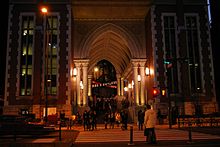
Mita Sai
Societies
In Japanese universities, there are student societies named "Circle". Although the accurate number is not clear, there are over 410 circles in Keio.
Festivals
Keio holds school festivals every year in each campus. The main festival is called "Mita Sai" on Mita campus, which is usually held in late November. Mita Sai includes various activities for not only entertainment but also academic purposes. It is also a research workshop for students on Mita campus. Approximately 200,000 people visit Mita Sai every year.
Athletics
Edward Bramwell Clarke and Tanaka Ginnosuke first introduced Rugby union to Japanese students at Keio University. (The game had been played in the treaty ports of Yokohama and Kobe before that, but not between Japanese teams.)
The interest of Keio's students in baseball stretches back to the early years of the 20th century; and the history of exhibition games was reported internationally. In 1913, an American professional team made of players from the New York Giants and the Chicago White Sox played the Keio team in an exhibition game. In a 1932 exhibition game, the Keio team beat the University of Michigan team which was then touring Japan. Keio's baseball team plays in the Tokyo Big6 Baseball League (six prominent universities in the Tokyo area).
Kei-So rivalry
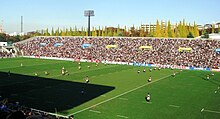
Kei-So Sen
Traditionally, there has been a strong rivalry between Keio and Waseda University. There are annually many matches between 2 universities in several sports, such as baseball, regatta and rugby. These games are called "Kei-So Sen", or more generally "So-Kei Sen".
The Kei-So baseball game is especially famous because of its over 100 year history and importance in Japanese baseball history. The most famous Kei-So baseball match was held on 1943/10/16, and it was made into a movie titled "The Last Game - the Final So-Kei Sen -" in 2008.
There are 2 Kei-So baseball game seasons every year and they are usually broadcasted by NHK. There is no lecture on all campuses in Keio on the game day because of the students who want to watch this match. Japanese emperors visited Kei-So baseball games 3 times in 1929,1950 and 1994.
Keio and Waseda have been often compared to each other in other general topics, such as their popularity and alumni's successes. In fact, there are many books and magazine articles which compared with these universities.
Finance
According to Keio's financial report, there was operating revenue of 197 billion yen in 2010. The top 3 largest incomes were from "Tuition and fees", "Medical care" and "Capital gain", with 49 billion yen, 48 billion yen and 21 billion yen respectively. The amount of endowments in 2010 was about 5 billion yen. Keio is known as having one of the largest financial endowments of any Japanese university.
On the other hand, the top 3 largest expenses in 2010 were "Compensation and benefits", "Education & Research" and "Investment", with 65 billion yen, 52 billion yen and 33 billion yen respectively. The total asset value in 2010 was about 364 billion yen with increase of 5 billion yen. In addition, the total amount of assets under management was approximetely 109 billion yen in 2010, composed by mainly cash, deposit with banks and marketable securities.
| Revenues | (yen in millions) | ratio | Expenses | (yen in millions) | ratio |
|---|---|---|---|---|---|
| Tuition and fees | 49,204 | 24.97% | Compensation and benefits | 65,270 | 33.12% |
| Investment return | 4,170 | 2.12% | Education & Research | 52,148 | 26.46% |
| Capital gain | 20,817 | 10.56% | Investment | 32,923 | 16.71% |
| National appropriation/Grants(Direct) | 17,082 | 8.67% | Repayment of debt | 13,236 | 6.72% |
| Medical care | 48,274 | 24.50% | |||
| Debt loan | 11,680 | 5.93% | |||
| Endowments | 5,475 | 2.78% | |||
| Total | 197,061 | 100.00% | Total | 197,061 | 100.00% |
Tuition fees
The university tuition fee system in Japan is different from other countries and very complicated. In the most Japanese universities, there are more payment requirements in the first year such as "entrance fees", and less in the rest of the years. There are several types of fees (some require to pay only once and some require to pay once or twice every year) and so-called "course fee" is officially only one of those fees.
In Keio university, Tuition fees are vary and depend on the course. Social Science & Humanity studies require the least fees with approximately 1,110,000 yen per year, and School of Medicine requires most expensive fees with about 3,610,000 yen per year. The tuition fees in graduate school are much less than those for undergraduate studies, as 690,000 yen per year for Social Science & Humanities and 1,313,000 yen per year for School of Medicine.
Although it is acceptable to pay twice with half in spring and half in autumn, "entrance fee" is necessary to be paid before the enrollment. Entrance fee for undergraduate study is 200,000 yen and the one for graduate study is 310,000 yen.
| Undergraduate | 4 years in Total (yen) | Per year (yen) |
|---|---|---|
| Social Science & Humanities | 4,440,000 | 1,110,000 |
| Natural Science & Engineering | 6,280,000 | 1,570,000 |
| SFC | 5,320,000 | 1,330,000 |
| School of Medicine | 14,440,000 | 3,610,000 |
| Graduate | 2 years in Total (yen) | Per year (yen) |
| Social Science & Humanities | 1,380,000 | 690,000 |
| Natural Science & Engineering | 1,965,000 | 983,000 |
| SFC | 2,071,000 | 1,035,000 |
| School of Medicine | 2,625,000 | 1,313,000 |
Scholarship/loan
There are many students who receive additional financial supports. In 2008, there were 9,764 students who used either scholarship or loan, and this number is about 30% of whole students. There are over 3,000 students who received scholarships with 300,000 yen on average, funded by Keio.
On the other hand, most of the international students somehow receive scholarship with 259,942 yen on average for undergraduate students and 517,473 yen on average for graduate students.
| 2008 | number of students | ratio | average amount (yen) |
|---|---|---|---|
| Total of using scholarship/loan | 9,764 | 30.25% | |
| Total of using scholarship funded by Keio | 3,000 | 9.30% | 300,000 |
| International Students(undergraduate) | 397 | appx. 100% | 259,942 |
| International Students(graduate) | 359 | appx. 75% | 517,473 |
Organisation

New South building on Mita Campus
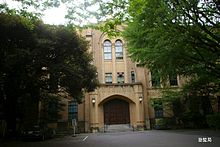
Jukukankyoku on Mita Campus
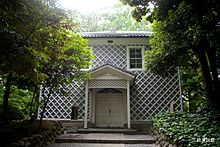
Mita speech house on Mita Campus

Hiyoshi Campus
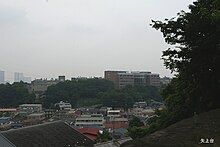
Yagami Campus
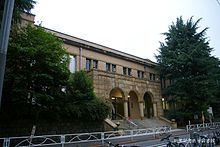
Kitasato Memorial Medical Library on Shinanomachi campus

3rd Building on Shiba Kyoritsu campus
Faculties(Entrance Capacity 6404)
It has nine faculties, which cover a wide range of academic fields, with each operating independently and offering broad educational and research activities. The faculties are:
- Faculty of Letters (800)
- Faculty of Economics (1200)
- Faculty of Law (1200)
- Faculty of Business and Commerce (1000)
- School of Medicine (112)
- Faculty of Science and Technology (932)
- Faculty of Policy Management (425)
- Faculty of Environment and Information Studies (425)
- Faculty of Nursing and Medical Care (100)
- Faculty of Pharmacy (210)
- Correspondence Courses(distance learning)
Graduate Schools
- Graduate School of Letters
- Graduate School of Economics
- Graduate School of Law
- Graduate School of Human Relations
- Graduate School of Business and Commerce
- Graduate School of Medicine
- Graduate School of Science and Technology
- Graduate School of Business Administration
- Graduate School of Media and Governance
- Graduate School of Health Management
- Graduate School of Pharmaceutical Sciences
- Law School
- Graduate School of Media Design
- Graduate School of System Design and Management
Media Centers
Keio Media Centers (Libraries)
Keio’s Media Centers, with combined holdings of over 4.58 million books and publications, are one of the largest academic information storehouses in the country.
- Mita Media Center
- Hiyoshi Media Center
- Media Center for Science and Technology
- Shinanomachi Media Center
- SFC Media Center
Information Technology Centers
- ITC Headquarters
- Mita ITC
- Hiyoshi ITC
- Shinanomachi ITC
- Science & Technology ITC
- Shonan Fujisawa ITC
Affiliated Schools
Elementary Education
- Keio Yochisha Elementary School
Secondary Education
- Keio Futsubu School (Boys Junior High School)
- Keio Chutobu Junior High School
- Keio Shonan Fujisawa Junior and Senior High School
- Keio Senior High School
- Keio Shiki Senior High School
- Keio Girls Senior High School
- Keio Academy of New York (High School)
Language Education
- Japanese Language Program
- Keio Foreign Language School
Others
- Keio Marunouchi City Campus (KMCC)
Hospital and Rehabilitation Center
Keio University Hospital is one of the largest and well-known general hospitals in Japan and is also a famous teaching hospital. Established in 1920, it has over 1,000 beds, a leading laboratory, and research and medical information divisions.
- Keio University Hospital
- Tsukigase Rehabilitation Center
Campuses
It has eleven campuses.
- Mita Campus (Mita, Minato ward, Tokyo)
- Hiyoshi Campus (Yokohama, Kanagawa)
- Yagami Campus (Yokohama, Kanagawa)
- Shinanomachi Campus (Shinjuku)
- Shonan Fujisawa Campus (Fujisawa, Kanagawa, aka SFC) designed by Fumihiko Maki
- Shiba Kyoritsu Campus (Minato ward, Tokyo)
- Shin-Kawasaki Town Campus (Kawasaki, Kanagawa)
- Tsuruoka Town Campus of Keio (Tsuruoka, Yamagata, aka TTCK)
- Urawa Kyoritsu Campus (Urawa, Saitama)
- Keio Osaka Riverside Campus (Osaka)
- Keio Marunouchi City Campus (Tokyo)
Current professors
There are 2,604 full time faculties in May 2011, including 789 professors, 406 associate professors, 362 lecturers and 1,047 other staffs (e.g. readers). There are several notable professors such as shown below.
Academic Rankings
Keio University is one of the most prestigious universities in Japan. It can be seen in the following rankings.
| Social Sciences & Humanities | ||
|---|---|---|
| LAW | ||
| Asahi National | Research | 2 |
| BE Success National | Qualification | 3 |
| BE Pass rate National | Qualification | 1 |
| ECONOMICS | ||
| RePec National | Research | 6 |
| BUSINESS & MANAGEMENT | ||
| Eduni MBA National | General | 1 |
| Eduni MBA World | General | 75 |
| CPA Success National | Qualification | 1 |
| Natural Sciences & Technology | ||
| Engineering | ||
| Nikkei National | Research | 8 |
General Rankings
The university has been ranked 2nd during 2007-2010 in the ranking called "Truly Strong Universities" by Toyo Keizai. In another ranking, Japanese prep school Kawaijuku ranked Keio as the 6th best university in Japan.
It was ranked 142nd in the world by Times Higher Education World University Rankings (2009). In its Asian University Ranking (2010), Quacquarelli Symonds also ranked Keio as 23rd in Asia. The Academic Ranking of World Universities (2010), which is compiled by Shanghai Jiao Tong University, ranks Keio 201-300 in the world and 27-43 in Asia.
Research Performance
Generally speaking, National Universities in Japan have better research standards, however Keio is one of the few Private Universities which compete with top National Universities. According to Thomson Reuters, Keio is the 10th best research university in Japan, and it's the only private university within Top 15. In addition, Weekly Diamond reported that Keio has the 8th highest research standard in Japan in terms of research fundings per researchers in COE Program, and it's also the only private university within Top 10.
Keio especially shows a high research standard in Materials science. According to Thomson Reuters, Keio is the 3rd best university in Japan in terms of citations per paper in Materials Science during 2005-2009. It was also ranked within top 7 in Neuroscience, Clinical medicine, Biology and Biochemistry, within top 10 in Molecular biology, Genetics, Psychiatry, Psychiatry, Psychology, Social Sciences, and Humanities in terms of citation per paper surveyed by National Institute of Informatics and Thomson Reuters during 2002 and 2006. Asahi Shimbun summarized the amount of academic papers in Japanese major legal journals by university, and Keio was ranked 2nd during 2005-2009.
Keio is also a leading university in Economics. According to Asahi Shimbun, Keio's been ranked 7th in Japan in the economic research ranking during 2005-2009. More recently, Repec in Jan 2011 ranked Keio's Economic department as Japan's 6th best economic research university. Keio has provided 3 presidents of Japanese Economic Association in its 42 year history, and this number is 5th largest.
In addition, Nikkei Shimbun on 2004/2/16 surveyed about the research standards in Engineering studies based on Thomson Reuters, Grants in Aid for Scientific Research and questionnaires to heads of 93 leading Japanese Research Centers, and Keio was placed 8th (research planning ability 4th/informative ability of research outcome 3rd) in this ranking.
Moreover, Keio has the largest asset size of patents among Japanese universities.
Graduate school Rankings
Keio Business School is Japan's earliest business school and one of only two Japanese business schools receiving a certification from The Association to Advance Collegiate Schools of Business (AACSB). It is ranked No. 1 in Japan by Nikkei Shimbun. Eduniversal also ranked Japanese business schools and Keio was top in Japan (75th in the world). In this ranking, Keio is one of 3 Japanese business schools categorized in "Universal Business schools with major international influence".
Keio Law School is considered as one of the top Japanese law schools, as Keio's pass rate for bar exam in 2010 was top (and 6th in 2009) in Japan.
Alumni Rankings
Keio has a unique alumni organization called Mita-Kai and it has a strong solidarity and massive influence in Japanese industries. It represents the strongest advantage and characteristic of this university.
According to the Weekly Economist's 2010 rankings and the PRESIDENT's article on 2006/10/16, graduates from Keio University have the 3rd best employment rate in 400 major companies, and the alumni's average salary is the 3rd best in Japan. École des Mines de Paris ranks Keio University as 3rd in the world in 2011 in terms of the number of alumni listed among CEOs in the 500 largest worldwide companies. The university is also ranked 1st in Japan for the number of alumni holding the position of executive in the listed companies of Japan, and this number per student (probability of becoming an executive) is also top.
Keio has been influential in Japanese medical societies as well. In fact, there have been 4 presidents of Japan Medical Association related to this university (2 Alumni and 2 professors). This number is the 2nd largest among Japanese medical schools. Keio is one of 2 Japanese universities which provided a president of World Medical Association.
For over 30 years, Keio graduates have been ranked first in Japan in the number of successful national CPA exam applicants.Furthermore, the number of Members of Parliament who graduated Keio has been 3rd in Japan.
Popularity and Selectivity
Keio is a popular university in Japan. The number of applicants per place was 11.7(48260/4098) in the 2011 undergraduate admissions. Its entrance difficulty is usually considered as top with Waseda among 730 private universities.
Nikkei BP has been publishing a ranking system called "Brand rankings of Japanese universities" every year, composed by the various indications related to the power of brand, and Keio was top in 2009 and 3rd in 2010 in Greater Tokyo Area.
The 4ICU ranking, which evaluates universities by web popularity instead of quality of education, classifies Keio as 1st in Japan, 2nd in Asia and 14th in the world. Webometrics (2008) also ranks Keio University as 3rd in Japan, 11th in Asia, and 208th in the world for quantity and quality of web presence and link visibility.
In a unique ranking, TBS ranked Japanese universities by the questionnaire of "Which university student do you want to have as your boyfriend?" to 300 girls in Shibuya, and Keio was ranked 1st in this ranking .
Alumni
Some of the prominent Keio alumni include: Japanese Prime Minister Junichiro Koizumi (2001–2006), Ryutaro Hashimoto (1996–1998), and Tsuyoshi Inukai (1931–1932). Dozens of other alumni have been cabinet members and governors in the post-war period. Its alumni include 230 CEOs of major companies and 97 CEOs of foreign affiliated companies (both highest in Japan). Keio has over 320,000 alumni in 866 alumni associations.
Politicians

Former (1931–1932) Japanese prime minister Tsuyoshi Inukai

Former (1996–1998) Japanese prime minister Ryutaro Hashimoto

Former (2001–2006) Japanese prime minister Junichiro Koizumi
- Junichiro Koizumi, the 87th/88th/89th Prime Minister of Japan (2001–2006), the 20th President of Liberal Democratic Party of Japan (Economics 1967)
- Ryutaro Hashimoto, the 82nd/83rd Prime Minister of Japan (1996–1998), the 17th President of Liberal Democratic Party of Japan (Law 1960)
- Tsuyoshi Inukai, the 29th Prime Minister of Japan (1931–1932), the 6th President of Rikken Seiyukai
- Ichirō Ozawa, Former President of Democratic Party of Japan, Former Secretary General of Liberal Democratic Party of Japan (Economics 1967)
- Tamisuke Watanuki, President of People's New Party, Former Speaker of The House of Representatives of Japan (Economics 1950)
- Kenji Kosaka, Minister of Education, Culture, Sports, Science and Technology (Law 1968)
- Jirō Kawasaki, Minister of Health, Labour and Welfare (Business and Commerce 1971)
- Andrew Thomson, Minister for Sport and Tourism and Minister Assisting the Prime Minister for the Sydney 2000 Games in the Australian Government 1997 - 1998
- Shigefumi Matsuzawa, Governor of Kanagawa (Law 1982)
- Akihiko Noro, Governor of Mie (Science and Technology 1969)
- Daijiro Yamashita, Governor of Kochi (Economics 1970 and Law 1972)
- Genjirō Kaneko, Governor of Nagasaki (Letters 1968)
- Hiroshi Nakai, Chairman of the National Commission on Public Safety, Minister of State for Disaster Management and the Abduction Issue (Economics 1969)
- Yūzan Fujita, Governor of Hiroshima (Business and Commerce 1972)
- Keiichi Inamine, Governor of Okinawa (Economics 1957)
- Ichiro Fujisaki, Chairman of Executive Committee of United Nations High Commissioner for Refugees (Law Dropout 1969)
- Shinichi Kitajima, Permanent Representative of Japan to the OECD (Economics 1971)
- Masaharu Ikuta, President of Japan Post, Former CEO of Mitsui O.S.K. Lines (Economics 1957)
- Atsushi Saito, CEO and President of Industrial Revitalization Corporation of Japan (Business & Commerce 1963)
- Hideo Shinozaki, Director General of National Institute of Public Health (Medicine)
- Toru Kawajiri, President of The National Institute for Defense Studies (Economics 1973)
- Yukio Ozaki, "Father of parliamentary politics" in Japan.
- Nobuteru Ishihara, Minister of Land, Infrastructure and Transport, Minister of State for Administrative and Regulatory Reform, Candidate for the LDP presidency 2008
- Hirofumi Nakasone, Minister for Foreign Affairs
- Masajūrō Shiokawa, Minister of Finances, Minister of Education and Chief Cabinet Secretary
- Hidenao Nakagawa, Chief Cabinet Secretary
- Mitsuo Horiuchi, Minister of International Trade and Industry
- Yoshiyuki Kamei, Minister of Agriculture, Forestry and Fisheries
- Ryu Shionoya, Minister of Education, Science and Technology
- Shigeru Ishiba, Minister of Defense, Minister of Agriculture, Forestry and Fisheries
- Kazuyoshi Kaneko, Minister of Land, Infrastructure, Transport and Tourism and Minister for Ocean Policy
- Takeo Kawamura, Minister of Education, Science and Technology and Chief Cabinet Secretary
- Akira Amari, Minister of Economy, Trade and Industry and Minister of State in charge of Administrative Reform
- Tatsuya Ito, Minister of State for Financial Services
- Tadamori Oshima, Minister of Agriculture
- Takeo Hiranuma, Minister of Transport and Minister of Economy, Trade, and Industry
- Akira Nagatsuma, Minister of Health, Labour and Welfare, Minister of State for Pension Reform
- Masajuro Shiokawa, Chief Cabinet Secretary of Japan
Finance
- Taizo Nishimuro, Chairman and CEO of Tokyo Stock Exchange, Former CEO of Toshiba Corporation (Economics 1961)
- Toshio Ando, Chairman of Japan Securities Dealers Association, Chairman of Nomura Asset Management (Law 1974)
- Shigeharu Suzuki, President and CEO of Daiwa Securities Group (Economics 1971)
- Junichi Arimura, President and CEO of Nikko Cordial Corporation (Business and Commerce 1973)
- Toshiaki Ito, CEO and President of JAFCO (Law 1971)
- Masanori Mochida, President of Goldman Sachs Japan (Economics)
- Kensuke Hotta, Chairman of Morgan Stanley Japan (Economics)
- Haruyasu Asakura, Managing Director and Head of Japan Growth Capital team of Carlyle Group (Science and Technology)
- Taisuke Sasanuma, Founder and Representative Partner of Advantage Partners (Law, MBA)
- Shigetoshi Yoshihara, Governor of the Bank of Japan
- Shigeharu Suzkui, President and CEO of Daiwa Securities Group
Media
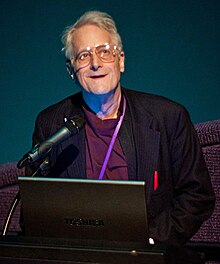
American sociologist Ted Nelson
- Shoichi Ueno, owner of The Asahi Shimbun (Law 1958)
- Tōru Shōriki, owner of The Yomiuri Shimbun (Economics 1942)
- Takuo Takihana, president of The Yomiuri Shimbun (Law 1963)
- Takehiko Kiyohara, chairman of The Sankei Shimbun (Law 1962)
- Nagayoshi Sumida, president of The Sankei Shimbun (Economics 1969)
- Michisada Hirose, chairman of The National Association of Commercial Broadcasting in Japan, Chairman of the Board of TV Asahi Corporation (Law 1958)
- Shintaro Kubo, president of Nippon Television Network (Economics 1968)
- Yukio Sunahara, chairman and CEO of Tokyo Broadcasting System (Letters 1961)
Other business people
- Akio Toyoda President and CEO Toyota Motor Corporation 2009-current
- Yutaka Asoh, later to be known as Yutaka Katayama, the first president of the U.S. operations of Nissan Motors (Economics 1935)
- Kakutaro Kitashiro, Leader of Japan Association of Corporate Executives, Chairman of IBM Japan (Science and Technology 1967)
- Katsuaki Watanabe, President of Toyota Motor Corporation (Economics 1964).
- Yuzaburo Mogi, Chairman and CEO of Kikkoman Corporation (Law 1958)
- Takashi Ushiku, President and COO of Kikkoman Corporation (Economics 1963)
- Shinzo Maeda, President and CEO of Shiseido (Letters 1970)
- Kazuyasu Kato, President of Kirin Brewery (Business and Commerce 1968)
- Yoji Ohashi, Chairman of the Board of All Nippon Airways (Law 1964)
- Shinji Yamamoto, Partner and Head of Bain and Company Japan (Economics 1982)
- Yoshiaki Sakito, President of Apple Computer Japan (Master Science and Technology 1983)
- Yoshio Nakamura, Acting Director General of Japan Business Federation
- Ichizō Kobayashi, Founder of Hankyu Railway and the Takarazuka Revue, Minister of Commerce and Industry in the 1940 Konoe Cabinet
- Fusanosuke Kuhara
- Nobutada Saji, Chief executive of Suntory Ltd.
- Toshio Kagami, CEO of Oriental Land Company
- Ikuo Nakagawa, CEO of Konica Minolta Danka Imaging
- Takao Kusakari, Chairman, Nippon Yusen Kaisha (NYK Line)
- Yoshiharu Fukuhara, Honorary Chairman of Shiseido Co., Ltd., and Director of Tokyo Metropolitan Museum of Photography
- Masamichi Toyama, Chairman of Smiles Co., Ltd.
- Yoshitoshi Kitajima, President of Dai Nippon Printing Company, Ltd.
Entertainment
- Nakata Atsuhiko, comedian/actor, (Economics)
- Tokumitsu Shuhei, (aka Mitsu Mangrove) TV Personality
- Ryo Fukawa, comedian (Economics)
- Yo Hitoto, singer (Environmental Studies)
- Ichikawa Ennosuke III, kabuki actor
- Yujiro Ishihara, actor (Dropout)
- Koji Ishizaka, actor
- Koide Keisuke, actor, (Literature)
- Takahiro Konagawa, musician, member of band, Charcoal Filter (Dropout)
- Asami Konno, singer, former member of group, Morning Musume (Currently attending), (Environmental Studies, admission office)
- Misako Konno, actress, Ambassadress of United Nations Development Programme
- Kreva, singer, member of Kick the Can Crew
- Takashi Matsumoto, lyricist, former member of Happy End
- Masataka Matsutoya, music producer
- Hiro Mizushima, actor (majoring Policy)
- Hiroshi Ōnogi, a screenwriter and novelist focused on anime productions
- Haruhiko Mikimoto an anime character designer, illustrator and manga artist
- Yusuke Miyazaki, musician (keyboardist/pianist)
- Kōyū Ohara, film director
- Sho Sakurai, singer, actor, newscaster, member of group Arashi (Economics)
- Koide Keisuke, actor (majoring in Literature)
- Hiromi Sakimoto, actor, singer, entertainment (Law)
- Koji Suzuki, horror author, author of Ring
- Mariya Takeuchi, musician (Literature, Dropout)
- Tigarah, Baile Funk emcee
- Kajirō Yamamoto, film director
- Fumi Yoshinaga, manga artist
- Yujiro, actor, television entertainer, Comedian
- Yukana, voice actress and singer (Law)
Art
- Rei Kawakubo, designer (founder of Comme des Garcons label)
- Yohji Yamamoto, Fashion Designer.
- Shusaku Endo, Akutagawa Prize, Order of Culture (Literature)
- Daigaku Horiguchi, Poet, Translator, Member of Japan Art Academy
- Etō Jun, literary critic
- Hiroshi Aramata, Professor of Nihon University
- Sakutarō Hagiwara, Poet
- Yumeno Kyūsaku, Surrealistic detective novelist
- Kazuki Kaneshiro, Zainichi Korean novelist
Thailand
- Tarisa Watanagase (Thai), Governor of the Bank of Thailand, 2006–2010 (Economics)
- Lernchai Marakarn (Thai), Governor of the Bank of Thailand, 1996-1997 (Money and Banking)
- Sommai Hoontrakool (Thai), Minister of Finance of Thailand, 1982-1986 (Economics)
Others
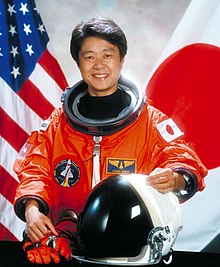
JAXA astronaut Chiaki Mukai
- Yusuke Amimori, gamer (Economics)
- Takeshi Fukuzawa, Executive Counsel, Mitsubishi Real Estate (Law)
- Akihiko Hoshide, JAXA astronaut
- Shichiro Ishikawa, president of the International Association for the Study of Lung Cancer
- Chiaki Mukai, surgeon and astronaut
- Zheng Nanning, president of Xi'an Jiaotong University, China (PhD, Engineering)
- Theodor Holm "Ted" Nelson, Computer architect, visionary, and contrarian (PhD, Media and Governance, 2002)
- Isao Obata, Shotokan karate master
- Ken Sakamura, professor of University of Tokyo, creator of TRON, Takeda Award (Engineering)
- Sosuke Sumitani, announcer (Economics)
- Tsunekazu Takeda, chairman of Japanese Olympic Committee (Law 1970)
- Taro Takemi, president of the World Medical Association and Japan Medical Association
- Yoshio Taniguchi, architect (Mechanical Engineering)
- Hiromoto Watanabe, first president of the Imperial University (now The University of Tokyo)
Gutenberg Bible
The only copy of a Gutenberg Bible held in a non-western country is the first volume of a Gutenberg Bible (Hubay 45) at Keio University—purchased on 22 October 1987 by Eiichi Kobayashi, a director at the Maruzen Company, for $5.4 million.
Gallery
 Previous South building on Mita Campus
Previous South building on Mita Campus
Maps

Mita Campus Map

Address:
2-15-45 Mita, Minato-ku, Tokyo, 108-8345 Japan
Phone:
+81-3-5427-1517
2-15-45 Mita, Minato-ku, Tokyo, 108-8345 Japan
Phone:
+81-3-5427-1517
- 8 min. walk from Tamachi Station
(JR Yamanote Line or JR Keihin-Tohoku Line) - 7 min. walk from Mita Station
(Subway Asakusa Line or Subway Mita Line) - 8 min. walk from Akabanebashi Station
(Subway Oedo Line)

1. North Building
Conference Hall, Faculty Club, Health Center, Office of Correspondence Courses, Facilities Department, Office of Alumni Affairs & Fund Raising, 150th Anniversary Commemorative Project Office, Admissions Center, North Hall, Meeting Rooms
2. Old University Library

Fukuzawa Memorial Center for Modern Japanese Studies, Institute of Oriental Classics(Shido Bunko), Conference Hall, Meeting Room
3. East Research Building

Global Security Research Institute, Project Rooms, G-SEC Seminar Room, Global Studio/ G-SEC lab, Meeting Room
4. Keio Corporate Administration "Jukukan-kyoku"
Office of the President, Office of Human Resource Management, Harassment Prevention Committee Office, Office for Global Initiatives, Project Office for Administrative & Management Reform, Administrative Affairs Office, Office of Communication and Public Relations, Accounting and Finance Office, Facility Management Office, Meeting Room
5. New University Library

Mita Media Center, Media Center Head Office
6. South School Building
Classrooms(411-477), The Banraisha Common Room, South Hall, Cafeteria, Group Study Room, Student Lounge, Student Counseling Room, Office of Student Services(Student Life Services Group, International Exchange Services Group, Scholarships and Financial Assistance Group, Careers Service & Teacher Training Course Support Group, General Affairs and Inquiries Group, Academic Affairs Group)
7. Public Speaking Hall "Mita Enzetsu-kan"

8. Temporary Office Building (removed)
9. Graduate School Building
Classrooms(313-375C), Research Rooms for Graduate Students, Institute for Media and Communications Research, Accounting Research and Education Center, Institute for Economic & Industrial Studies, Institute of East Asian Studies, Information Technology Center, Mita Information Technology Center, Keio Institute of Law and Political Science
10. First School Building
Classrooms(101-147), Office of Foreign Language School, Research for Foreign Language Education
11. Faculty Research Building
Office of Faculties of Letters, Economics, Law and Business & Commerce, Mita Office of Research Administration, Deans Offices, Meeting Room A & B, Research Rooms, Office for Faculty Service
12. Keio Trade Union
13. West School Building
Classrooms(501-545), Cafeteria, Club Rooms, West Hall
14. South Building

Classrooms (2B11-2B42), Chair Office, Center for Integrated Education System, Office for New Educational Initiatives, Office of Student Services, Teacher Training Center, Library, Distance Learning Room, Moot Court Room, Research Rooms, Roof Terrace, Academic Staff Room & AV Support Room, Student Counseling Room
15. University Co-op
16. West Building
Office of Keio University Athletic Association, Internal Audit Services, Office of Mita Bungaku
West Annex
Institute of Cultural & Linguistic Studies
East Annex
Yonsei Tokyo Office at Keio
South Annex
Headquarters for Research Coordination and Administration, Research Center for the Arts & Arts Administration, Art Space
Hiyoshi Campus Map

Address:
4-1-1 Hiyoshi, Kohoku-ku, Yokohama, Kanagawa 223-8521
Phone:
+81-45-566-1000
4-1-1 Hiyoshi, Kohoku-ku, Yokohama, Kanagawa 223-8521
Phone:
+81-45-566-1000
- 1 min. walk from Hiyoshi Station (Tokyu Toyoko Line or Yokohama Municipal Subway Green Line)
- *Ltd. Express trains of Tokyu Toyoko Line do not stop at Hiyoshi Station.

1. Hiyoshi Library
2. Fourth Building, Section A
Classrooms (J411-J447)
3. Fourth Building, Section B
Classrooms (J11-39)
4. Fourth Building Independence Wing
Classrooms (DB105-DB203, D101-D413), Hiyoshi Communication Lounge
5. Fifth Building (removed)
6. Sixth Building
Classrooms (J611-643, Seminor 1, Seminor 2), Greens Terrace
7. Third Building
Classrooms (301-336), Foreign Language Lounge
8. Student Union Building "Jukusei Kaikan"

Training Room, Club Rooms
9. Cafeteria Building

Club Rooms
10. "Raiosha"

Faculty Office, Meeting Room, Symposium Space, Faculty Lounge
11. University Co-op
12. Fujiyama Memorial Hall
Classrooms(F01-F11), Meeting Room
13. Seventh Building
Classrooms (701,703,704),
14. Second Building
Classrooms (214,221,224,231,234)
15. Gymnasium, Sports Building
Institute of Physical Education, Judo and Kendo Hall, Table Tennis Court
16. Eighth Building
Classrooms (811,812,831)
17. Hiyoshi Commemorative Hall
18. Building One
Senior High School
19. Sports Medicine Research Center
20. Health Center

21. Senior High School Gymnasium
22. Senior High School Judo Gymnasium
23. Collaboration Complex
Graduate Schools, Library, Office of Community and Regional Affairs, Hall, Child Care Center, Fitness Club, Cafe, Restaurant, Convenient StoreYagami Campus Map

Address:
3-14-1 Hiyoshi, Kohoku-ku, Yokohama, Kanagawa 223-8522
Phone:
+81-45-566-1454
3-14-1 Hiyoshi, Kohoku-ku, Yokohama, Kanagawa 223-8522
Phone:
+81-45-566-1454
- 15 min. walk from Hiyoshi Station (1km) (Tokyu Toyoko Line or Yokohama Municipal Subway Green Line)
*Ltd. Express trains of Tokyu Toyoko Line do not stop at Hiyoshi Station. - 10 min. by taxi from Shin-Kawasaki Station (2km) (JR Yokosuka Line)

1. 11th Building
Lecture Rooms
2. 12th Building
Lecture Rooms
3. 14th Building "Sosokan"

Deans Office, Administrative Affairs Office, Facility Management Office, Office of Research Grants (Yagami Branch), Cafeteria, Science and Technology Information Technology Center, Multimedia Room, Forum
4. 15th Building

Information and Media Center for Science and Technology (Matsushita Memorial Library), Digital Content Studio
5. 16th Building-A

Health Center, University Co-op, Hall, Cafeteria
16th Building-A has a cafeteria and a co-op store in 16th Building. Both are crowded with students and staff at mealtimes.
16th Building-A has a cafeteria and a co-op store in 16th Building. Both are crowded with students and staff at mealtimes.
6. 16th Building-B
Clubroom Building
7. 16th Building-D
Research Center for Molecules, Supra-Molecules and Supra-Structured Material
8. 22nd Building
9. 23rd Building
10. 24th Building : Student Lounge, Alumni Association
11. 25th Building : Student Affairs Office, Academic Affairs Office, International Center
12. 26th Building : Center Service Facilities for Science and Technology Research, Student Counseling room
13. 27th Building : Gymnasium
14. 31st Building
15. 32nd Building
16. 33rd Building
17. 34th Building
18. 35th Building
19. 36th Building
9. 23rd Building
10. 24th Building : Student Lounge, Alumni Association
11. 25th Building : Student Affairs Office, Academic Affairs Office, International Center
12. 26th Building : Center Service Facilities for Science and Technology Research, Student Counseling room
13. 27th Building : Gymnasium
14. 31st Building
15. 32nd Building
16. 33rd Building
17. 34th Building
18. 35th Building
19. 36th Building

Buildings numbered 20s through 30s form two rows, and they are mostly research and experiment facilities.
Shinanomachi Campus Map

Address:
35 Shinanomachi, Shinjuku-ku, Tokyo 160-8582
Phone:
+81-3-3353-1211
35 Shinanomachi, Shinjuku-ku, Tokyo 160-8582
Phone:
+81-3-3353-1211
- 1 min. walk from Shinanomachi Station (JR Sobu Line)
- 5 min. walk from Kokuritsu-Kyogijo Station (Subway Oedo Line)

1. New Hospital Wing
2. University Co-op
3. Wing 6 Wards
4. Wing 7 Wards
5. Radiographic Diagnosis Center
6. Central Wing
7. Restaurant
8. Flower Shop
9. Wing 1 Wards
10. Department of Rehabilitation Medicine Building
11. Clinical Research Institute
12. Clinical Research Hall
13. CT Building
14. MR Building
15. " Koyosha "
16. " Rengakan "

17. East Lecture Hall
18. Sports Ground
19. Education and Research Building
20. Second Lecture Hall
21. Institute of Integrated Medical Research

22. Building for Preventive Medicine & Public Health
23. The Waksman Foundation of Japan, Inc.
24. Kitasato Memorial Library (Shinanomachi Media Center)

25. Dormitory (Kobai-ryo)
26. Dormitory (Hakubai-ryo)
27. Building for Clinical Research
28. Cafe
29. Makeshift Building E
30. Makeshift Building D
31. Building 3 (North Wing)
32. Building 3 (South Wing) *be scheduled for completion in April, 2012
Shonan Fujisawa Campus Map

Address:
5322 Endo, Fujisawa-shi, Kanagawa 252-0882
Phone:
+81-466-49-3404
5322 Endo, Fujisawa-shi, Kanagawa 252-0882
Phone:
+81-466-49-3404
- 15 min. by bus from Shonandai Station (Odakyu Enoshima Line, Sotetsu Izumino Line, or Yokohama Municipal Subway Blue Line)
- 25 min. by bus from Tsujido Station (JR Tokaido Line)

1. Alpha Building

Main Building
2. Omega Building
3. Mu Building

Media Center

4. Kappa Building
5. Epsilon Building
6. Iota Building
7. Omicron Building
5. Epsilon Building
6. Iota Building
7. Omicron Building
8. Lambda Building
9. Theta Building
10. Delta Building
11. Tau Building
Graduate School Building
12. Psi Building
13. Phi Building
14. Gamma Building
Gymnasium
15. Sigma Building

Co-op & Cafeteria
16. Student Lounge
17. Gulliver Pond(Kamoike)
18. Faculty of Nursing and Medical Care

19. Keio Fujisawa Innovation Village
20. Seminar Guesthouse
21. Nu Building
22. Zeta Building
23. Keio Shonan Fujisawa Junior and Senior High School
24. Japanese Archery Range
Bus Stop
A Keio Daigaku
B Keio Daigaku Honkan Mae
C Chuko Koshajo
D Keio Chukotobu Mae
Shiba-Kyoritsu Campus Map

Address:
1-5-30 Shibakoen, Minato-ku, Tokyo 105-8512
Phone:
+81-3-3434-6241
1-5-30 Shibakoen, Minato-ku, Tokyo 105-8512
Phone:
+81-3-3434-6241
- 10 min. walk from Hamamatsucho Station
(JR Yamanote Line or Keihin-Tohoku Line) - 2 min. walk from Onarimon Station
(Subway Mita Line) - 6 min. walk from Daimon Station
(Subway Asakusa Line or Subway Oedo Line)

1. Building NO.1
Roof Terrace, Medicinal Plant Garden, Gymnasium (Multipurpose Hall), Fitness Center, Cafeteria, Kiosk, Administrative Offices (Student Affairs), Multimedia Lecture Hall

Building No.1

Roof Terrace

Fitness Center

Cafeteria

Multimedia Lecture Hall
2. Building NO.2
Memorial Hall, Counseling Room, Classrooms, Laboratories, Animal Center
3. Building NO.3
Seminar Room, Faculty Offices, Laboratories, Multimedia Computer Room, Information and Media Center for Pharmacentical Sciences,
Community Pharmacy, Administrative Offices(General Affairs, Accounting),
Center for Biophylatic Research
Community Pharmacy, Administrative Offices(General Affairs, Accounting),
Center for Biophylatic Research

Shiba-kyoritu Pharmaceutical Library (Media Center)

Community Pharmacy
Photo of University

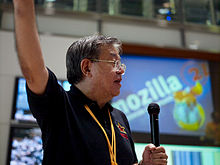





















































No comments:
Post a Comment